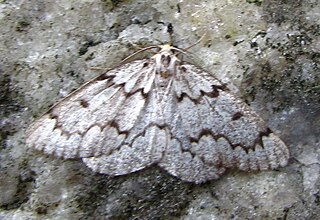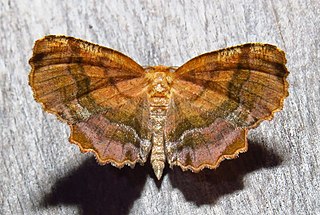
The geometer moths are moths belonging to the family Geometridae of the insect order Lepidoptera, the moths and butterflies. Their scientific name derives from the Ancient Greek geo γεω, and metron μέτρον "measure" in reference to the way their larvae, or inchworms, appear to measure the earth as they move along in a looping fashion. Geometridae is a very large family, containing around 23,000 described species; over 1400 species from six subfamilies are indigenous to North America alone. A well-known member is the peppered moth, Biston betularia, which has been the subject of numerous studies in population genetics. Several other geometer moths are notorious pests.

The scalloped oak is a moth of the family Geometridae. The species was first described by Carl Linnaeus in his 1758 10th edition of Systema Naturae.

The Ennomini are a tribe of geometer moths in the Ennominae subfamily. They are large-bodied and rather nondescript Ennominae, overall showing many similarities to the closely related Azelinini and Nacophorini.

The Ourapterygini are one of the large tribes of geometer moths in the subfamily Ennominae. The tribe was described by Charles Théophile Bruand d'Uzelle in 1846. They are particularly plentiful in the Neotropics. Ourapterygini are generally held to be the youngest tribe of their subfamily, and at least seasonally have characteristic apomorphic asymmetrical processes of the anellus.

Cepphis advenaria, the little thorn, is a moth of the family Geometridae. The species can be found in Europe and across the Palearctic to Japan.

Ennomos alniaria, the canary-shouldered thorn, is a moth of the family Geometridae. The species was first described by Carl Linnaeus in his 1758 10th edition of Systema Naturae. It can be found in Europe in a wide variety of biotopes where there are deciduous trees, perhaps mostly in deciduous forests and gardens.

Monoctenia smerintharia, more commonly known as the dark leaf moth, is a moth of the family Geometridae first described by Rudolf Felder and Alois Friedrich Rogenhofer in 1875. It is found in Australia. The larvae feed on the leaves of gum trees.
Chlorodontopera is a monotypic moth genus in the family Geometridae described by Warren in 1893. Its only species, Chlorodontopera chalybeata, described by Frederic Moore in 1872, is found in the north-eastern Himalayas, northern Vietnam, Myanmar, Borneo and Sumatra.

Crocallis is a genus of moths in the family Geometridae erected by Georg Friedrich Treitschke in 1825.

Dyscia is a genus of moths in the family Geometridae erected by Jacob Hübner in 1825.

Enypia is a genus of moths, commonly called girdle moths, in the family Geometridae.

Eutrapela is a genus of moths in the family Geometridae. It contains only one species, Eutrapela clemataria, the curve-toothed geometer moth or purplish-brown looper, which is found in North America, where it has been recorded from Nova Scotia to Florida, west to Texas and north to Saskatchewan. The habitat consists of deciduous and mixed woodlands.

Hyperythra is a genus of moths in the family Geometridae. It was erected by Achille Guenée in 1857.

Medasina is a genus of moths in the family Geometridae. The Global Lepidoptera Names Index lists it as a junior subjective synonym of Chorodna. Species are distributed throughout India, Sri Lanka and Myanmar.
Nadagara is a genus of moths in the family Geometridae first described by Francis Walker in 1861.

Sterrhinae is a large subfamily of geometer moths with some 3,000 described species, with more than half belonging to the taxonomically difficult, very diverse genera, Idaea and Scopula. This subfamily was described by Edward Meyrick in 1892. They are the most diverse in the tropics with the number of species decreasing with increasing latitude and elevation.

Rheumaptera undulata, the scallop shell, is a moth of the family Geometridae. It was first described by Carl Linnaeus in his 1758 10th edition of Systema Naturae. It is found in most of the Palearctic realm and North America.
Louis Beethoven Prout (1864–1943) was an English entomologist and musicologist.

Cepphis decoloraria, the dark scallop moth, is a species of geometrid moth in the family Geometridae.

Cepphis armataria, the scallop moth, is a species of geometrid moth in the family Geometridae. It is found in North America.

















